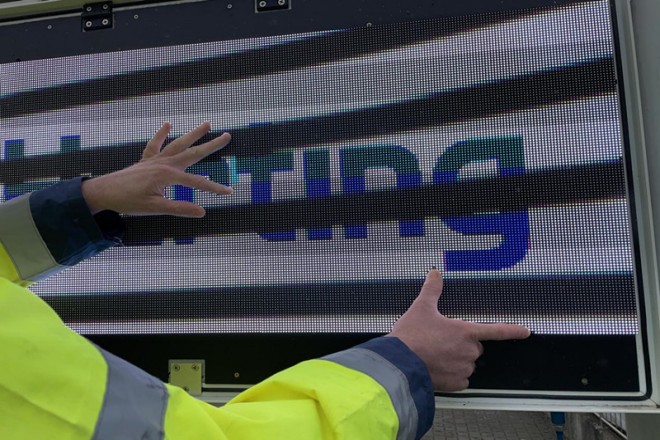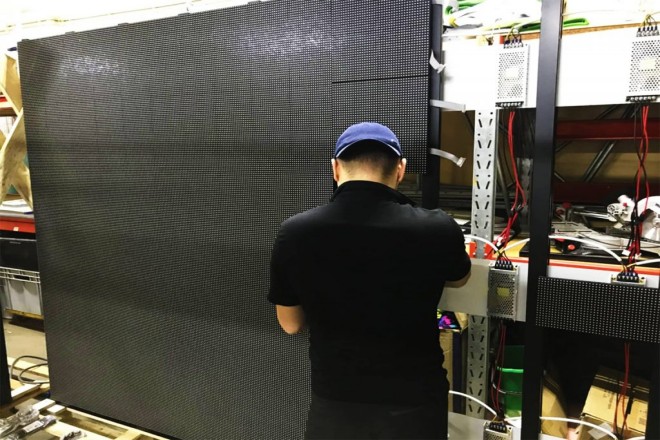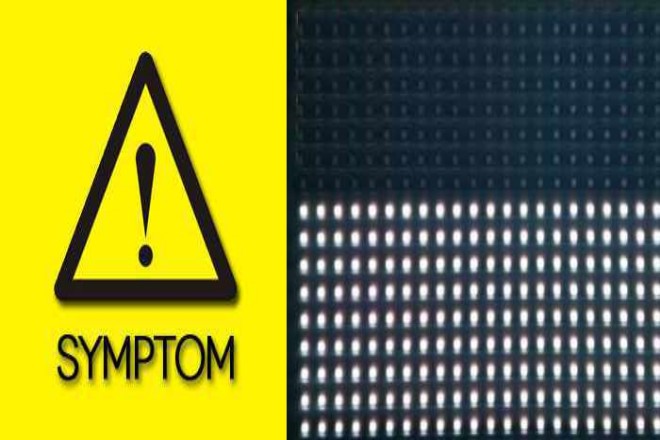介绍
1. 单杠问题简介
横条问题,特别是在 LED 显示屏中,通常是指显示屏上出现水平线条或条纹的现象。这些线条可能会干扰视觉信息的正常显示,并降低显示屏的清晰度和可读性。
1). 单杠问题的具体表现
LED显示屏横条问题具体表现可能包括以下几个方面:
线条粗细不一:水平线条的宽度可能不一致;有的线条较粗,有的线条较细。
颜色不同:线条的颜色可能与显示屏上的其他内容不同,或者线条本身的颜色不一致。
固定或移动位置:线条可能出现在显示屏上的固定位置,也可能在显示屏上移动。固定位置线条可能是由于显示屏的某个部分出现故障而引起的,而移动线条可能是由于信号干扰或电源问题而引起的。
异常 亮度 或对比度:线条的亮度或对比度可能与显示器上其他内容不同,这可能是由于显示器的背光系统或信号处理系统出现故障造成的。
闪烁或跳动:在某些情况下,线路可能会闪烁或跳动,这可能是由于电源不稳定或信号干扰造成的。
横条问题会影响LED显示屏的视觉效果和用户体验,因此当发现显示屏出现横条时应及时检查、修复。
这可能需要检查显示器的硬件连接、电源稳定性、信号传输质量等,以确保显示器能够正常显示内容。
同时,定期对LED显示屏进行维护和保养也是预防横条问题的重要措施。
2.单杠问题原因分析

作为LED显示屏常见的技术故障之一,横条问题产生的原因复杂多样,但我们可以从以下几个方面进行详细、通俗易懂的分析:
1). 显示连接问题:连接不稳定,信号受阻
- 连接线松动或者损坏:
试想一下,如果你家里的电线插头没有插紧,或者电线被老鼠咬坏了,电视机都可能无法正常播放画面。
同样,如果LED显示屏的连接线出现松动或者损坏,就如同线材的插头没有插好或者被咬坏一样,也会导致信号在传输过程中不稳定,从而在屏幕上形成横条。
- 端子接触不良:
终端就像是连接线与显示器的“握手”,如果它们之间接触不够紧密,就像两个人握手时手指没有握紧,信号在传输过程中就会“泄露”,导致屏幕出现横条。
2). 控制系统故障:大脑错误,指令混乱
- 控制系统硬件故障:
控制系统就像LED显示屏的大脑,负责接收指令、控制显示屏的显示。
如果脑内的芯片或者电路板出现了问题,就像人得了脑炎或者中风一样,就会导致指令传递的混乱,从而在屏幕上形成横条。
- 控制系统软件问题:
软件就像大脑里的程序,指挥大脑如何工作,如果软件出现错误或者参数设置不当,就像一个精神分裂症或者记忆障碍的人,显示屏接收到的指令就会不正确,导致屏幕上出现横条。
3).显示屏本身问题:身体疾病,显示异常
- 灯珠损坏或者老化:
灯珠就像显示屏上的小灯泡,负责发光,如果灯泡坏了或者老化了,发出的光线就会不均匀,在屏幕上形成横条或者暗点。
- 驱动芯片故障:
驱动芯片就好比是控制灯泡开关的遥控器,如果遥控器坏了,灯泡就不能正常亮、灭,造成显示屏上的像素点不能正常工作,从而在屏幕上形成横条。
- 显示板内部电路损坏、或背光模块故障:
显示面板内部的电路就好比身体里的血管,负责输送营养物质(信号)。
如果血管堵塞或者破裂,营养物质就无法正常运输,导致显示屏上某些区域无法正常工作,从而在屏幕上形成横条。
背光模组是提供光源的部件,若其发生故障,也会造成显示屏发光不均匀,形成横条。
4).其他因素:外界干扰,环境恶劣
- 信号源问题:
信号源就像是显示器的指令来源。
如果信号源出现问题,比如信号线松动、接触不良,或者信号源设备故障,都会导致显示器接收到的指令不完整或者错误,从而在屏幕上形成横条。
- 环境因素:
温度、湿度等环境因素也会影响显示器的正常工作。
比如温度过高会造成显示器内部电子元器件过热失效,从而在屏幕上形成横条;湿度过大会造成电路短路或者腐蚀,也会导致显示器出现故障。
综上所述,横条问题产生的原因可能涉及到显示器的连接、控制系统、显示器本身等多个方面。
在排除和解决单杠问题的时候,我们需要像医生诊断疾病一样,逐一检查可能的原因,并采取相应的措施进行修复。
3. 单杠问题的解决方法
当LED显示屏出现横条问题时,我们可以采取一系列详细且易于理解的步骤来解决它。下面是这些步骤的详细解释:
1). 仔细检查连接线
- 全面检查:
拿起工具箱,逐一检查从控制系统到显示器的每条连接线。这包括显示器背面或底部的隐藏电线。确保它们没有松动或断裂。
可以轻轻摇晃每根电线,听听是否有松动的声音,或者观察电线是否有明显的损坏迹象。
- 终端稳定性:
除了电线本身以外,还要检查电线与显示器或控制系统之间的端子连接是否牢固。
使用小钳子或者螺丝刀等工具,轻轻按压端子,确保它们与电线和接口紧密接触。
2).重启并检查控制系统
- 重启尝试:
有时,控制系统可能会因为暂时的软件故障或配置错误而出现横杆问题。此时,您可以尝试重新启动控制系统,看看问题是否解决。
关闭控制系统电源,等待几秒钟后,再打开,观察显示是否恢复正常。
- 深入调查:
如果重新启动后问题仍然存在,则需要更深入地检查控制系统的硬件和软件部分。
检查控制系统电路板是否有烧毁、损坏的迹象,芯片是否正常工作。
同时检查控制系统的软件设置,确保与显示器的硬件、分辨率等参数相匹配。
3).逐个检查显示模块
- 模块检查:
如果连接线和控制系统都没有问题,那么问题可能就出在显示屏本身,此时需要对显示屏的各个模块或者单元逐一进行检查。
将显示屏分成几个区域,逐个检查每个区域是否有横条。这可能需要您使用专业的测试工具或软件来协助诊断。
- 修理或更换:
一旦找到有问题的模块或单元,就需要维修或更换。这可能涉及更换损坏的灯珠、驱动芯片或整个面板模块。
由于这些操作需要一定的专业知识和工具,因此建议寻求专业维护人员的帮助。
4).调整信号源及接口
- 信号源检查:
有时横条问题也可能是信号源设备的问题,因此需要检查信号源设备是否正常工作,信号线是否连接牢固。
确保信号源设备的输出信号与显示器的接收信号兼容,信号线质量良好,无损坏、老化。
- 接口检查与更换:
除了信号线本身以外,还需要检查显示器的接口是否有故障。
观察接口是否有松动,变形或者损坏的迹象,如果发现接口有问题,可以尝试更换接口线或者修复接口。
4. 预防单杠问题的措施

预防LED显示屏横条问题的措施至关重要,可以帮助我们减少出现故障的可能,延长显示屏的使用寿命,下面就来详细讲解预防横条问题的措施:
1).定期检查连接线及接口
- 定期维护:
显示屏与控制系统之间的连接线及接口是信号传输的关键部位,因此需要定期进行维护检查。
建议每季度或每半年进行一次全面检查,确保所有连接线和接口处于良好的工作状态。
- 紧固与防护:
检查时要特别注意连接线、接口的紧固情况,确保无松动、损坏。
可以采用专业的紧固工具或者粘合剂来加强连接线、接口的稳定性,防止使用过程中发生松动。
2).做好散热工作
- 加强散热措施:
LED显示屏在运行过程中会产生一定的热量,如果散热不良,可能会导致控制系统或者显示屏本身出现故障。
因此需要加强显示屏的散热措施,如安装冷却风扇、散热器等,保证显示屏在运行时有适中的温度。
- 定期检查冷却系统:
除了加强冷却措施外,还应定期检查冷却系统的工作状况。
如果发现冷却风扇转速变慢、散热器被堵塞等问题,应及时清理或更换,以保证冷却系统正常工作。
3). 选择优质产品
- 品牌及品质:
购买LED显示屏时,应该选择优质的产品和可信赖的品牌。
高质量的产品通常具有较高的可靠性和稳定性,可以降低发生故障的可能性。
- 售后服务:
除了产品质量外,还应该关注品牌的售后服务。
选择提供完善售后服务的品牌,这样在遇到问题的时候可以及时得到技术支持和维修服务,减少维修成本和时间。
结论
综上所述,LED显示屏横条问题是一个技术问题,涉及的因素很多,但通过认真检查、科学分析、有效处理,我们完全有能力将其影响降到最低。
无论是连接线的问题、控制系统的故障、显示屏本身的缺陷,甚至是来自信号源或环境因素的干扰,只要我们掌握了正确的解决和预防措施,就能够保证LED显示屏运行在最佳状态,持续为我们提供优质的视觉体验。
最后,如果您想了解更多关于LED显示屏的知识, 请与我们联系。

